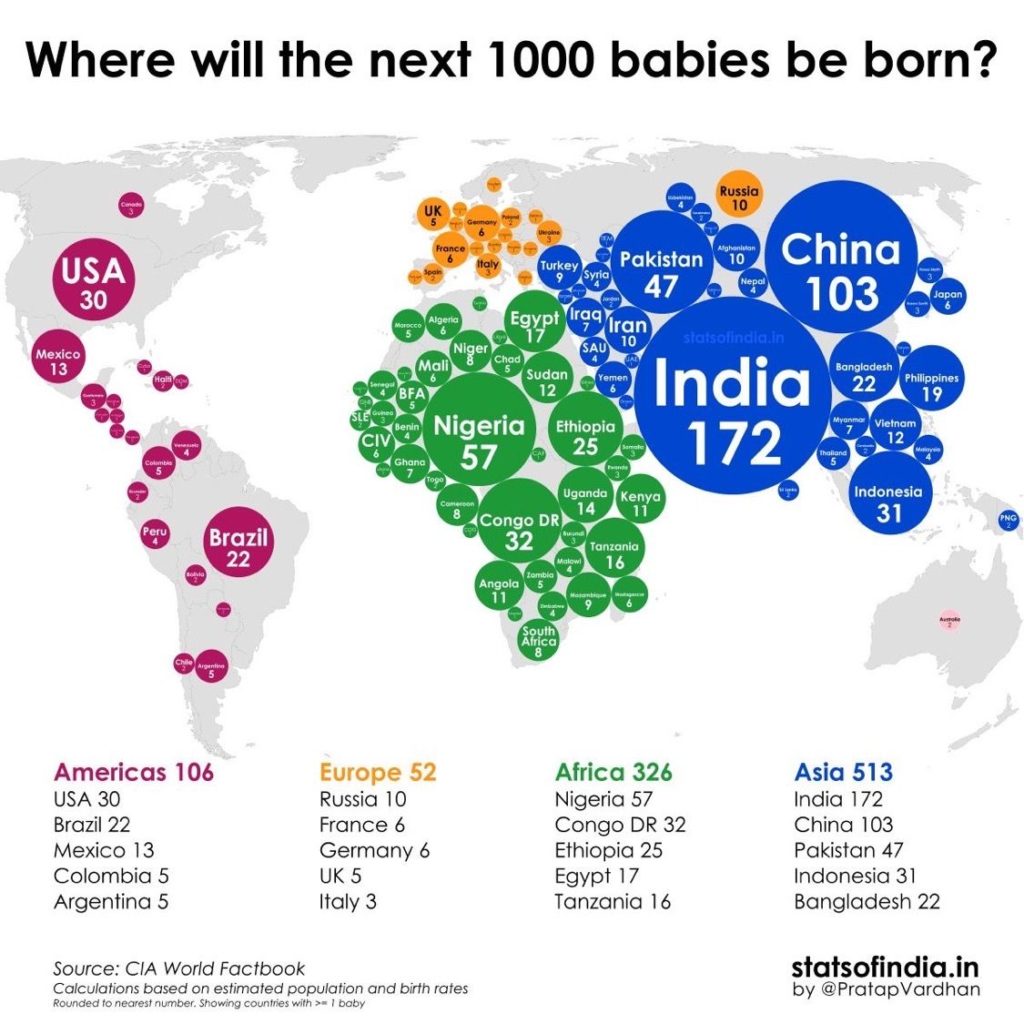
In 2023, if not already, India will take over China as the world’s most populous country.
A key determinant of the global population rate is women’s average number of children over their lifetime – the ‘fertility rate.’ Fertility rates have fallen rapidly across the world in recent decades. In 1950, the average woman gave birth around 5 times. Since then, fertility rates have more than halved. In 2021, this global figure was 2.3 births per woman.
If you switch to the map tab in the interactive chart, you see that most people in the world now live in countries where fertility rates are at – or below – the ‘replacement level.’ This is the level at which populations stabilize or shrink over the long term. The UN reports that two-thirds of people live in countries where the fertility rate is below 2.1 births per woman. In some high-income countries such as South Korea, Japan, Spain, or Italy, it is as low as 1.3 births per woman.
China has been the world’s most populous country for decades. It is now home to more than 1.4 billion people. However, its population growth rate has fallen significantly following a rapid drop in its fertility rate over the 1970s and 80s.
The fertility rate in India has also fallen substantially in recent decades – from 5.7 births per woman in 1950 to just 2 births per woman today. However, the rate of this decline has been slower. The UN expects India will overtake China as the most populous country in the world in 2023.
Since 1975 the world has added a billion people every 12 years.
It passed its last milestone – 7 billion in 2011. And, by the end of 2022, it will pass another one: there will be 8 billion people in the world.
While this rate of absolute growth is similar to previous decades, the growth rate continues to fall. Since 2019, the global population growth rate has fallen below 1%.
That’s less than half its peak rate of growth – of 2.3% – in the 1960s.
As global fertility rates continue to fall (see below), this rate will continue to fall.
The global population is projected to peak at 10.4 billion in 2086
The world population has increased rapidly over the last century. When will it come to an end?
Previous versions of the UN World Population Prospects showed a significant slowdown in population growth, with very slow growth – almost reaching a plateau – by the end of the century. Its previous release projected that the world population would be around 10.88 billion in 2100 and would not yet have peaked.
In this new release, the UN projects that the global population will peak before the end of the century – in 2086 at just over 10.4 billion people.1
There are several reasons for this earlier and lower peak. One is that the UN expects fertility rates to fall more quickly in low-income countries compared to previous revisions. It also expects less of a ‘rebound’ in fertility rates across high-income countries in the century’s second half.
The UN estimates around 15 million excess deaths in 2020 and 2021 from the COVID-19 pandemic
The Coronavirus (COVID-19) pandemic has had a significant impact on global population and migration trends.
We know that the confirmed death toll from COVID-19 is likely to significantly underestimate the true number of deaths because of limited testing. One way to get a better estimate of the total mortality impact of the pandemic is to look at excess mortality data. We can look at the total number of deaths and compare this to the number we expect to occur in a non-pandemic year.
In its latest population dataset, the UN estimates that in 2020, there were approximately 5 million excess deaths. In 2021, this figure was 10 million.
This estimate of 15 million excess deaths over 2020 and 2021 is in line with estimates from other organizations. The Economist put its central estimate of excess deaths at 17.6 million. The World Health Organization, which is a UN organization, estimated 14.9 million excess deaths.
These death figures are highly uncertain. But what’s clear is that the number of confirmed deaths – which was just 5.4 million by the end of 2021 – captures just a fraction of the true impact of the pandemic.




40 Comments
Pingback: shiba inu puppies for sale uk
Pingback: Magic mushroom capsule
Pingback: data hongkong
Pingback: Buy Guns online
Pingback: KS Lumina
Pingback: เครื่องมือแพทย์ความงาม
Pingback: lottobet หวย สะดวก เล่นได้ทุกที่ รองรับทุกระบบ
Pingback: โปรแกรมพรีเมียร์ลีก
Pingback: relaxing piano music
Pingback: site
Pingback: lsm99
Pingback: moroccan hash canada
Pingback: เปิดบัญชีเทรด Forex
Pingback: ทะเบียนประมูล
Pingback: โปรโมชั่น ติดใจ 888
Pingback: เกมสล็อตยอดนิยมจากค่าย PragmaticPlay Slot
Pingback: ส่งพัสดุ
Pingback: Bilad Rafidain
Pingback: poker
Pingback: Ufamax24
Pingback: Scienc1e
Pingback: joker369
Pingback: สมัคร pg slot
Pingback: betflix wallet
Pingback: Login
Pingback: Afrikaanse oorbel
Pingback: 5 bet casino แนะนำ ค่ายคาสิโนยอดนิยม
Pingback: หวยปิงปอง ต้องเลือกเล่นผ่านที่ไหน ?
Pingback: เว็บสล็อตตรง จากต่างประเทศ ไม่มีขั้นต่ำ
Pingback: Mostbet Aviator
Pingback: Star168 เว็บบาคาร่า
Pingback: นำเข้าสินค้าจากจีน
Pingback: โคมไฟ
Pingback: 7slots
Pingback: ไข่สั่น
Pingback: บาคาร่าเกาหลี
Pingback: เว็บปั้มไลค์
Pingback: gioca al casinò
Pingback: เว็บบาคาร่าที่น่าเชื่อถือ คืออะไร
Pingback: แว่นกันแดด